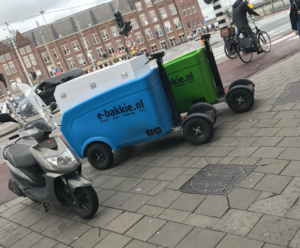The demand for instant deliveries has existed for some time but until recently was seen as a niche service in areas such as urgent document or pizza deliveries. The rise in e-commerce and the changing habits of consumers has resulted in a dramatic change in the demand for instant deliveries and also a major increase in available services like Deliveroo and Foodora.
The speed of the change has been such that not only are city planning and policies lagging behind in addressing the consequences but in the same way there is yet to be an established business model for such services.
Research
An exploratory research by Laetitia Dablanc, Eleonora Morganti, Niklas Arvidsson, Johan Woxenius, Michael Browne and Neïla Said indicates that instant deliveries may already account for 2.5% of all freight delivery trips in a large city. The growth in instant deliveries raises the possibility of a significant increase in small vehicle movements in the middle of already very busy city centres. If this trend were to continue for the next few years then the results would be of major concern in terms of the impact on the urban street space and kerbside.
The desire of consumers for new services and their willingness to use recently developed apps to access them shows every sign of increasing. Yet at the same time it appears that consumers are unwilling to pay very much (or even at all) for such services. This raises a problem of profitability. Part of it is ‘ solved’ through the nature of employment for those working to provide instant deliveries. Self employed courier cyclists have limited or no job security and a demanding work environment, which can lead to concerns about safety and the behaviour of the couriers involved. These concerns will rise as the services grow.
Business model – value creation
One of the brakes on service growth may be the reluctance of investors to continue to provide funding when profits and return on investment still seem a long way in the future. Even in the short time since 2015 there has been a marked decline in the willingness of investors to continue with funding for all services: a selection is now taking place, which should lead to accelerated bankruptcies and mergers in the sector.
Already it is possible to discern various categories of instant delivery service and in many cases the ones that are growing most rapidly appear to be those that result in single shipments being moved from the collection point to a delivery address. This can create negative consequences in terms of traffic congestion and the impact on the environment. However, environmental and air quality impacts are moderated by the nature of many of these deliveries which currently involve the use of bicycles or in some cases on-foot delivery. Yet as the volumes rise and time becomes even more critical and there is a search to expand the range over which such deliveries can be accomplished it seems likely that other transport modes will also grow with potentially greater environmental consequences.
Technology
The next few years will be characterised by a stronger focus on optimising services and ensuring that quality of service is achieved. One way in which this will happen is through the application of technology but another path is from the growing partnerships between organisations with a strong logistics or retailing tradition and those companies that have entered a rapidly changing market (such as, recently, Postmates and Starbucks, or Stuart with La Poste group and Franprix). Another potential direction of change is consolidation.
The very nature of instant deliveries (many of them courier deliveries of single consignments, on short distances and with little time) makes consolidation difficult. Some companies try to overcome these challenges: Amazon Prime Now in Paris has sufficient orders to consolidate at least three to five deliveries per trip before a delivery vehicle leaves the urban warehouse.
Finally, P2P (or ‘ pure’ crowd-sourced deliveries), involving private individuals using spare transport capacity on their way to work, shops or leisure, may also grow, as a niche market. As DHL mentioned to us about their DHL MyWays test, ‘There is something in this anyways. We had to leave it for now. We will pick it up when it has reached maturity.’
Urban planning
Predicting the consequences of these dramatic changes in combination is extremely difficult. But it is essential that city planning and policies take account of these developments and consider how planning and possibly regulation needs to be adapted to these new ways of doing things.
These trends extend to land use planning where it is becoming increasingly clear that there is a need to re-think the provision of logistics spaces in cities if we are to avoid the rise of increasingly fragmented deliveries. Such planning will also have to harness the interest of the real estate companies that in recent years have sought opportunities for large scale developments on the edge of the city.
Source:
Laetitia Dablanc, Eleonora Morganti, Niklas Arvidsson, Johan Woxenius, Michael Browne & Neïla Saidi (2017):
The rise of on-demand ‘Instant Deliveries’ in European cities in Supply Chain Forum: An International Journal

